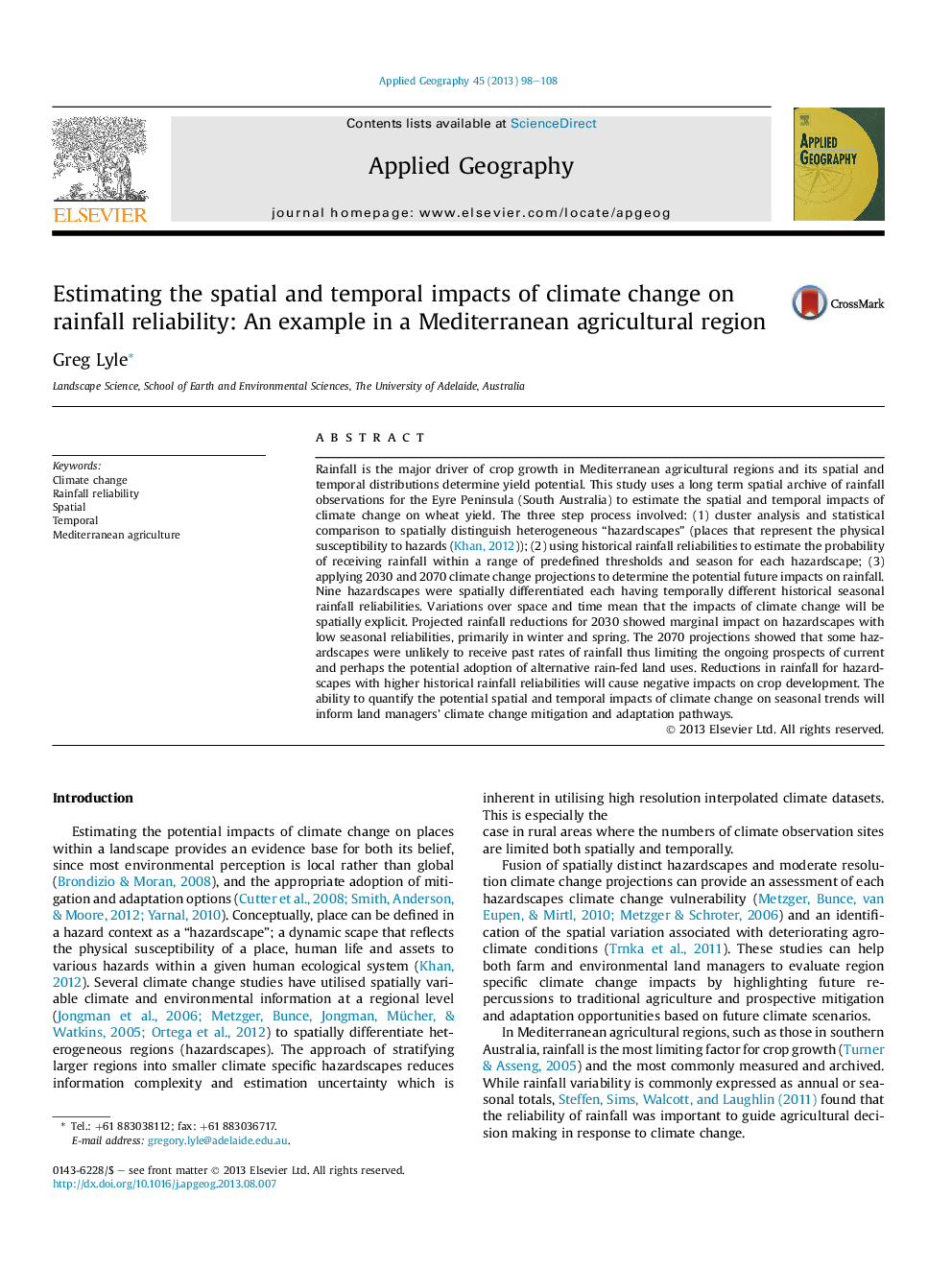| کد مقاله | کد نشریه | سال انتشار | مقاله انگلیسی | نسخه تمام متن |
|---|---|---|---|---|
| 6538786 | 158726 | 2013 | 11 صفحه PDF | دانلود رایگان |
عنوان انگلیسی مقاله ISI
Estimating the spatial and temporal impacts of climate change on rainfall reliability: An example in a Mediterranean agricultural region
ترجمه فارسی عنوان
برآورد اثرات فضایی و زمانی تغییرات اقلیمی بر قابلیت اطمینان بارش: مثال در یک منطقه کشاورزی مدیترانه
دانلود مقاله + سفارش ترجمه
دانلود مقاله ISI انگلیسی
رایگان برای ایرانیان
کلمات کلیدی
تغییر آب و هوا، قابلیت اطمینان بارش فضایی، موقتی کشاورزی مدیترانه ای،
ترجمه چکیده
بارش باران اصلی رشد محصول در مناطق کشاورزی مدیترانه است و توزیع فضایی و زمانی آن، پتانسیل تولید را تعیین می کند. این مطالعه از یک آرشیو فضایی بلند مدت مشاهدات بارندگی برای شبه جزیره ایور (جنوب استرالیا) برای ارزیابی اثرات مکانی و زمانی تغییرات آب و هوایی بر عملکرد گندم استفاده می کند. فرآیند سه مرحله شامل موارد زیر است: (1) تجزیه و تحلیل خوشه ای و مقایسه آماری به صورت فضایی، تشخیص خطرات ناهمگن (مکان هایی که حساسیت فیزیکی به خطرات را نشان می دهند (خان، 2012))؛ (2) با استفاده از بارندگی های تاریخی تاریخی برای برآورد احتمال بارش باران در طیف وسیعی از آستانه های پیش بینی شده و فصل برای هر خطر خطرات؛ (3) استفاده از پیش بینی های تغییرات اقلیمی 2030 و 2070 برای تعیین تاثیرات احتمالی آینده در بارندگی. 9 خط مخاطره به صورت فضایی تمایز داشتند، هر کدام دارای ریسک بارندگی فصلی تاریخی متفاوت بودند. تغییرات در فضا و زمان به این معنی است که اثرات تغییرات آب و هوایی، به صورت فضایی آشکار خواهد شد. کاهش بارش پیش بینی شده در سال 2030 تاثیر منفی بر خطرات خطرناکی با رفاه فصلی کم داشت، عمدتا در زمستان و بهار. پیش بینی های 2070 نشان داد که بعضی از خطرات به احتمال زیاد به میزان بارش گذشته می رسند، بنابراین محدود کردن چشم انداز های فعلی و احتمالا استفاده از زمین های جایگزین با استفاده از زمین های جایگزین فعلی و احتمالا ممکن است. کاهش بارندگی در حوادث خطرناک با رفع بیشتر بارندگی های تاریخی منجر به تاثیرات منفی بر رشد محصول خواهد شد. توانایی برای اندازه گیری تاثیرات فضایی و زمانی بالقوه تغییرات آب و هوایی بر روند فصلی، مسیرهای انعطاف پذیری و تغییرات اقلیمی مدیران زمین را اطلاع می دهد.
موضوعات مرتبط
علوم زیستی و بیوفناوری
علوم کشاورزی و بیولوژیک
جنگلداری
چکیده انگلیسی
Rainfall is the major driver of crop growth in Mediterranean agricultural regions and its spatial and temporal distributions determine yield potential. This study uses a long term spatial archive of rainfall observations for the Eyre Peninsula (South Australia) to estimate the spatial and temporal impacts of climate change on wheat yield. The three step process involved: (1) cluster analysis and statistical comparison to spatially distinguish heterogeneous “hazardscapes” (places that represent the physical susceptibility to hazards (Khan, 2012)); (2) using historical rainfall reliabilities to estimate the probability of receiving rainfall within a range of predefined thresholds and season for each hazardscape; (3) applying 2030 and 2070 climate change projections to determine the potential future impacts on rainfall. Nine hazardscapes were spatially differentiated each having temporally different historical seasonal rainfall reliabilities. Variations over space and time mean that the impacts of climate change will be spatially explicit. Projected rainfall reductions for 2030 showed marginal impact on hazardscapes with low seasonal reliabilities, primarily in winter and spring. The 2070 projections showed that some hazardscapes were unlikely to receive past rates of rainfall thus limiting the ongoing prospects of current and perhaps the potential adoption of alternative rain-fed land uses. Reductions in rainfall for hazardscapes with higher historical rainfall reliabilities will cause negative impacts on crop development. The ability to quantify the potential spatial and temporal impacts of climate change on seasonal trends will inform land managers' climate change mitigation and adaptation pathways.
ناشر
Database: Elsevier - ScienceDirect (ساینس دایرکت)
Journal: Applied Geography - Volume 45, December 2013, Pages 98-108
Journal: Applied Geography - Volume 45, December 2013, Pages 98-108
نویسندگان
Greg Lyle,
